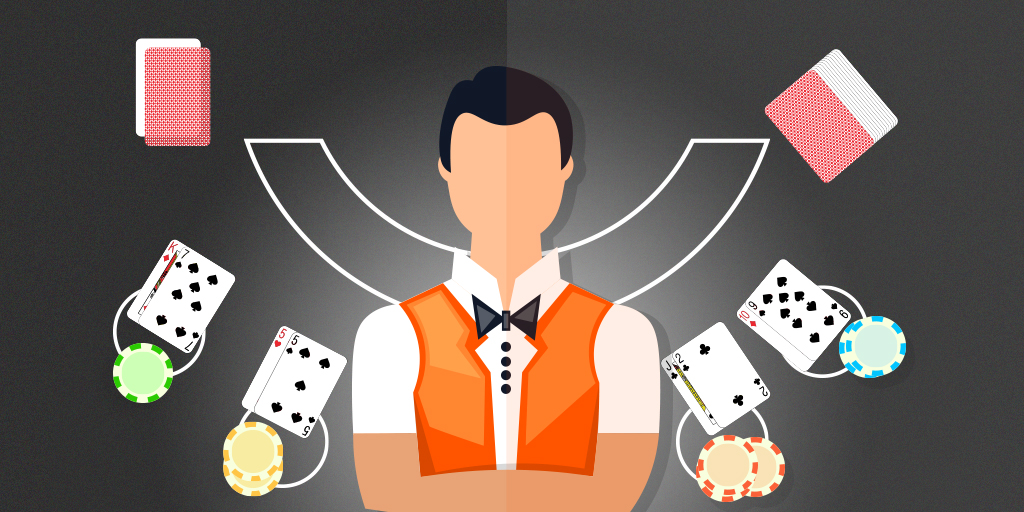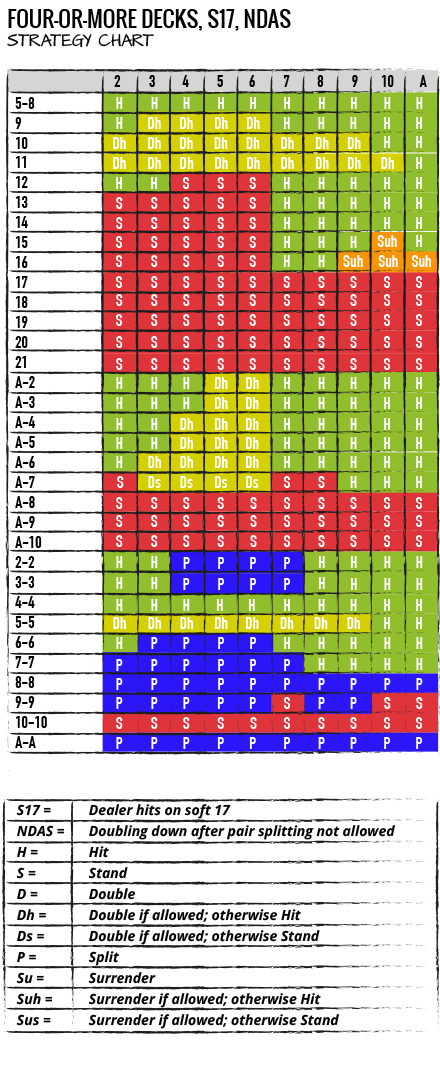When To Split On Blackjack

How To Know When To Hit On 16
Splitting in Blackjack You can split in the game of Blackjack when the cards that you are holding match each other. You can also sometimes split when the cards have equal value. Some casinos permit you to split any two face cards even if these two face cards do not match each other (i.e. Two Queens just of a different suit).
- Published on Monday, 06 May 2013 17:17
- Written by Sam
- 0 Comments
- In most versions of Blackjack, when you are dealt a pair (two of the same card), you have the option to split them into two new hands. You are dealt two more cards (one for each new hand) and your bet is doubled. You play each hand normally — you get two chances to beat the dealer (or lose).
- A player can split in a round of Blackjack if their opening two cards are of the same value. This means any pair from Ace through to nine and any two cards valued at ten (for instance, a ten and a Queen).
Probably the worst situation to be in at the blackjack table is to be dealt a 16 while the dealer has a 7 or higher showing. Blackjack charts from all across the world say to hit the 16 when the dealer is showing a 7 or higher, even surrendering in some situations. If you want to beat the casino, you’re going to have to do better than that. So let me share with you one of my key winning blackjack plays…
Never hit your 16.
You say, “but I can’t beat the dealer’s 20 with my 16!”
And you’re right.
But you definitely can’t beat the dealer if you’ve busted out. And you’ll lose nearly 70% of the time when you hit your 16.
Here’s the statistics. If you hit on your 16, you’ll win 25.23% of the time, push 5.46% of the time, and you will lose 69.31% of the time. That’s a net loss of 44.08% when you hit your 16.
If you stand on your 16, you’ll win 29.01% of the time, push 0%, and lose 70.99% of the time. This is a net loss of 41.98% — so by standing on your 16, you’ll be cutting your losses by 2.1%!
In the situation where you are dealt a 16, you have to realize that you’re probably going to lose, and you need to simply deal with that fact.
You need to stand on the 16 to give yourself the greatest chance of not losing.
Be patient, because you’ll make your money at the blackjack table with the better hands that you’re dealt…
In my book, I give you everything you need to enjoy the results I enjoy at the Blackjack table. All my plays are detailed in the strategy chart found in the book. I even have a pocket sized laminated version of my strategy card available from my website that will help you make the perfect play every time. And I’ll even autograph the book if you buy from my website. That’s an exclusive offer that you can’t get anywhere else.
Blackjack Splitting Rules
If you’ve ever played blackjack, you already know that if you get two identical cards in a hand, you can split them into two separate hands. This action is referred to as a “split”. These two hands are then treated as two separate players. Each of them may be split again (in case of getting another identical card) or doubled.
The basic strategy for blackjack clearly defines the situations when the player should split cards in blackjack and when to play without splitting them. This knowledge is absolutely crucial for most professional players because it reduces the house edge and in addition, gives the player a substantial chance of winning.
Generally speaking, according to the optimal strategy, there are three options for a hand consisting of two identical cards:
- Always split pairs
- Never split pairs
- Play by dealer’s card
Always Split Pairs In Blackjack
When To Split In Blackjack Youtube
Remembering when it’s always good to split in blackjack is easy. This rule only applies to two pairs – aces and eights. There is a very simple reason for splitting aces. The maximum value of two aces is 12 (11 + 1). The only card to make a blackjack from 12 is 9. A much more likely scenario occurs when the player gets another card with a value of 10. This case may result either in bust (exceeded 21) or a 12 (1 + 1 + 10).
The logic behind splitting eights is very similar. The value of a pair of eights is only 16, which is a very unfortunate sum in blackjack. It is too low for winning and too high for a hit because more than two-thirds of the cards in the deck will get you over 21.
Some casinos allow a so-called resplit – splitting of a pair that has already been split. The same rule applies here, too. If possible, always resplit both eights and aces.
Never Split Pairs in Blackjack
Although it may seem illogical, it is true that a player should never split a pair of cards with a value of 10. Why? The total value is 20, which is very good and the only thing that trumps such a pair is getting an ace. The probability of this happening is, however, very small and the player is more likely to get two lower-value hands.

The next pair that should never be split is a pair of fives. By splitting them you only get a worse starting position with two weak hands. In addition, a sum of 10 is advantageous, especially if the dealer’s face card has the same or lower value.
Play by the dealer’s card
The remaining pairs are split depending on the dealer’s face card to maximize the mathematical probability of winning. The following rules apply:
- 2, 3 and 7 – always split if the dealer’s face card is 7 or lower
- 4 – split only if the dealer’s face card is 5 or 6
- 6 – split only if the dealer’s face card is 6 or lower
- 9 – always split except when dealer’s face card is 7, 10 or ace
To remember this strategy better, follow the table below.
| Pairs | 2 | 3 | 4 | 5 | 6 | 7 | 8 | 9 | 10 | A |
| 2,2 | Sp | Sp | Sp | Sp | Sp | Sp | H | H | H | H |
| 3,3 | Sp | Sp | Sp | Sp | Sp | Sp | H | H | H | H |
| 4,4 | H | H | H | Sp | Sp | H | H | H | H | H |
| 5,5 | D | D | D | D | D | D | D | D | H | H |
| 6,6 | Sp | Sp | Sp | Sp | Sp | H | H | H | H | H |
| 7,7 | Sp | Sp | Sp | Sp | Sp | Sp | H | H | H | H |
| 8,8 | Sp | Sp | Sp | Sp | Sp | Sp | Sp | Sp | Sp | Sp |
| 9,9 | Sp | Sp | Sp | Sp | Sp | S | Sp | Sp | S | S |
| 10,10 | S | S | S | S | S | S | S | S | S | S |
| Ace,Ace | Sp | Sp | Sp | Sp | Sp | Sp | Sp | Sp | Sp | Sp |
Legend:
Blackjack Splitting Strategy
| S | Stand |
| Sp | Split |
| D | Double |
| H | Hit |
Splitting pairs for card counters
As usual with blackjack, players using card counting techniques may in some cases deviate from the optimal strategy. Most often we see this in case of insurance that is otherwise considered disadvantageous – a sucker bet. However, this is also the case with the splitting rules. In some cases, card counters shouldn’t split a pair of aces or should split a pair of tens.
First, we will show how card counting can affect the player’s decision. If the card count is high and positive (e.g. +5, +6 or more), it is obviously advantageous to split the aces because the player knows that the deck contains more cards worth 10 which means a greater chance of blackjack.
The player will not split aces if the value is negative. In this case, the deck contains fewer cards with a value lower than 10. At the same time, the dealer should have a high card, i.e. a card with a value of 8, 9 or 10. We’ll show an example.
Let’s say the player has two aces and his count is -5. The dealer has a card with a value of 10. The player splits the pair according to the optimal strategy, and the next cards he gets are 3 and 5. After splitting, it is no longer possible to play, so he has to face the dealer’s card with a value of 10 and hands worth only 14 and 16, respectively. That is not a very pleasant situation. In such a case, it is better not to split the aces and rather draw another card, because regardless of what the player gets, he can’t bust.
The same logic can also be applied to the decision whether to split cards worth 10. Generally, we should never split these cards, but there is an exception that applies if the count is negative and the dealer has a low card (e.g. 4, 5 or 6). The player thus has a higher chance of getting at least 20 on one of the hands, which is very hard to beat with a low card.